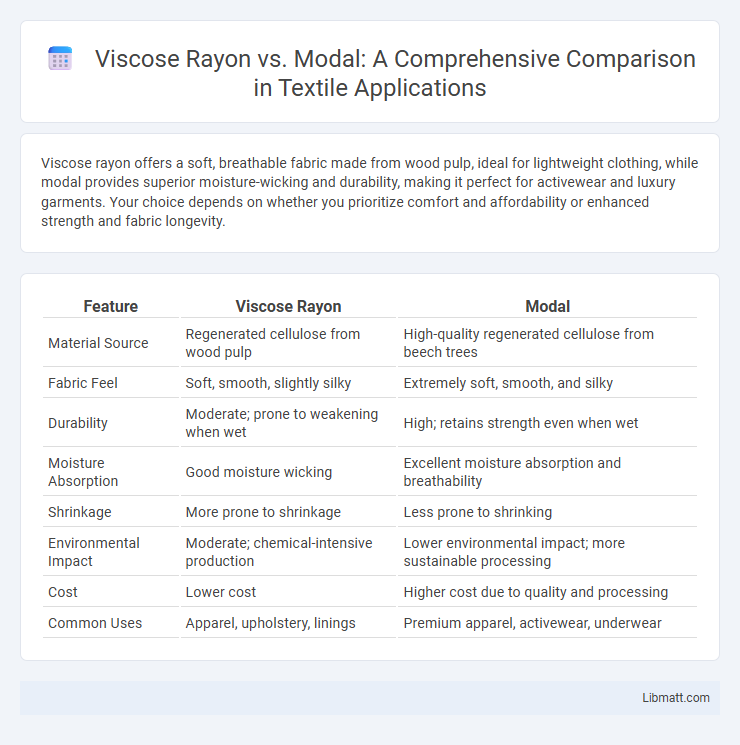Viscose rayon offers a soft, breathable fabric made from wood pulp, ideal for lightweight clothing, while modal provides superior moisture-wicking and durability, making it perfect for activewear and luxury garments. Your choice depends on whether you prioritize comfort and affordability or enhanced strength and fabric longevity.
Table of Comparison
| Feature | Viscose Rayon | Modal |
|---|---|---|
| Material Source | Regenerated cellulose from wood pulp | High-quality regenerated cellulose from beech trees |
| Fabric Feel | Soft, smooth, slightly silky | Extremely soft, smooth, and silky |
| Durability | Moderate; prone to weakening when wet | High; retains strength even when wet |
| Moisture Absorption | Good moisture wicking | Excellent moisture absorption and breathability |
| Shrinkage | More prone to shrinkage | Less prone to shrinking |
| Environmental Impact | Moderate; chemical-intensive production | Lower environmental impact; more sustainable processing |
| Cost | Lower cost | Higher cost due to quality and processing |
| Common Uses | Apparel, upholstery, linings | Premium apparel, activewear, underwear |
Introduction to Viscose Rayon and Modal
Viscose rayon is a semi-synthetic fiber made from regenerated cellulose derived from wood pulp, known for its softness, breathability, and smooth texture. Modal is a type of high-wet-modulus rayon produced using beech tree pulp, offering enhanced strength, durability, and a silky finish compared to traditional viscose. Your choice between viscose rayon and modal affects fabric performance, with modal typically providing better moisture-wicking properties and resistance to shrinkage.
Origins and Production Processes
Viscose rayon and modal both originate from cellulose fibers extracted primarily from wood pulp, with viscose rayon being the first generation regenerated cellulose fiber developed in the late 19th century. The production of viscose rayon involves chemically treating cellulose with sodium hydroxide and carbon disulfide to create a viscous solution, which is then spun into fibers. Modal undergoes a similar but more refined production process with higher quality beech wood pulp and improved spinning techniques, resulting in fibers that are stronger, more resistant to shrinking, and often considered a sustainable alternative with enhanced softness and durability for your textiles.
Chemical Composition Comparison
Viscose rayon and modal are both semi-synthetic fibers made from cellulose derived from wood pulp, but modal undergoes a more extensive chemical treatment, resulting in higher purity and enhanced fiber strength. The viscose production process uses sodium hydroxide and carbon disulfide to convert cellulose into a viscous solution, while modal employs a similar but refined method with increased washing stages that reduce harmful residues. Your choice between viscose and modal impacts fabric durability and softness due to these differences in chemical composition and processing.
Environmental Impact and Sustainability
Viscose Rayon production typically involves high water usage and chemical processes that contribute to deforestation and pollution, making it less environmentally sustainable. Modal, derived primarily from beech tree pulp, uses a more eco-friendly closed-loop process that recycles chemicals and water, resulting in a lower environmental footprint. Choosing Modal over Viscose Rayon supports your commitment to sustainable fashion by reducing resource consumption and minimizing harmful emissions.
Texture and Feel: Comfort Differences
Viscose Rayon offers a smooth, silk-like texture with a lightweight and breathable feel, making it comfortable for warm weather. Modal provides a softer, more luxurious touch with superior moisture-wicking properties, enhancing comfort during prolonged wear. Your choice between these fabrics can influence how comfortable and breathable your clothing feels throughout the day.
Durability and Performance
Viscose rayon offers moderate durability with a smooth texture but tends to weaken when wet, limiting its performance in high-moisture environments. Modal, a type of rayon derived from beech tree pulp, provides superior strength and resilience, maintaining fabric integrity after repeated washing and drying cycles. Its enhanced durability and moisture-wicking properties make modal a preferred choice for activewear and long-lasting textiles.
Cost and Market Availability
Viscose Rayon is generally more affordable and widely available in global markets due to its well-established production processes and higher demand. Modal, derived from beechwood pulp, tends to be costlier but offers superior durability and softness, leading to a niche yet growing market presence. Your choice between the two depends on budget constraints and the desired fabric quality for your specific application.
Common Uses in Fashion and Textiles
Viscose rayon is widely used in fashion for its silky texture and breathability, making it ideal for dresses, blouses, and linings. Modal, a type of rayon derived from beech trees, offers superior softness and durability, commonly utilized in underwear, activewear, and loungewear. Your choice between viscose rayon and modal depends on whether you prioritize a lightweight, breathable fabric or a resilient, ultra-soft material for everyday wear.
Care and Maintenance Requirements
Viscose rayon requires gentle washing in cold water and should be air-dried to prevent shrinking and maintain fabric softness, while modal is more durable and resistant to shrinking, allowing for machine washing in warm water and tumble drying on low heat. Both fabrics benefit from avoiding bleach to preserve fiber integrity and color vibrancy. Proper care extends the lifespan of modal and viscose rayon, ensuring sustained comfort and appearance in clothing and textiles.
Choosing Between Viscose Rayon and Modal
Choosing between viscose rayon and modal depends on factors like fabric softness, durability, and environmental impact. Modal offers superior softness and better resistance to shrinkage and pilling compared to viscose rayon, making it ideal for high-quality clothing. Viscose rayon is more affordable and breathable but less durable, often used in lightweight garments and linings.
Viscose Rayon vs Modal Infographic

 libmatt.com
libmatt.com